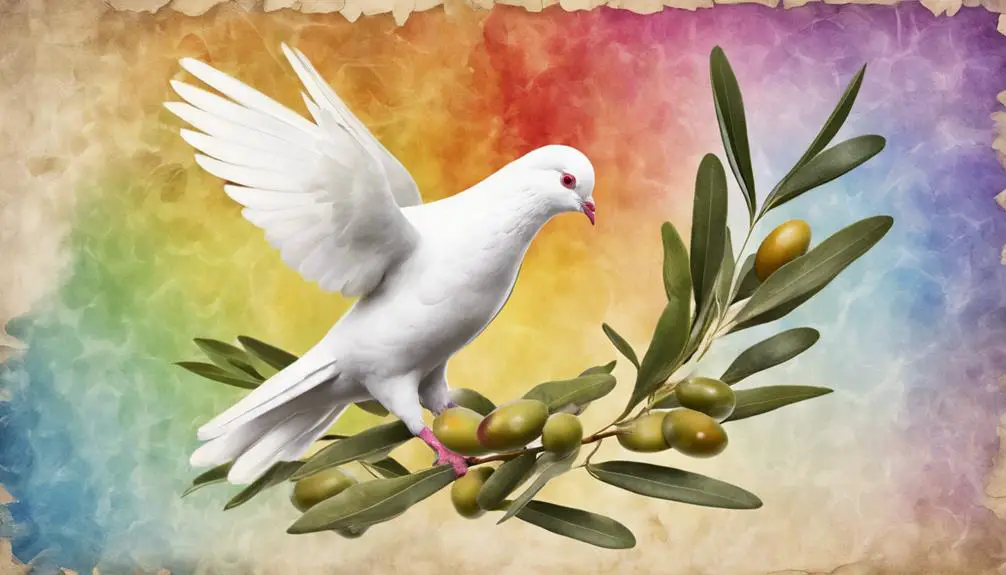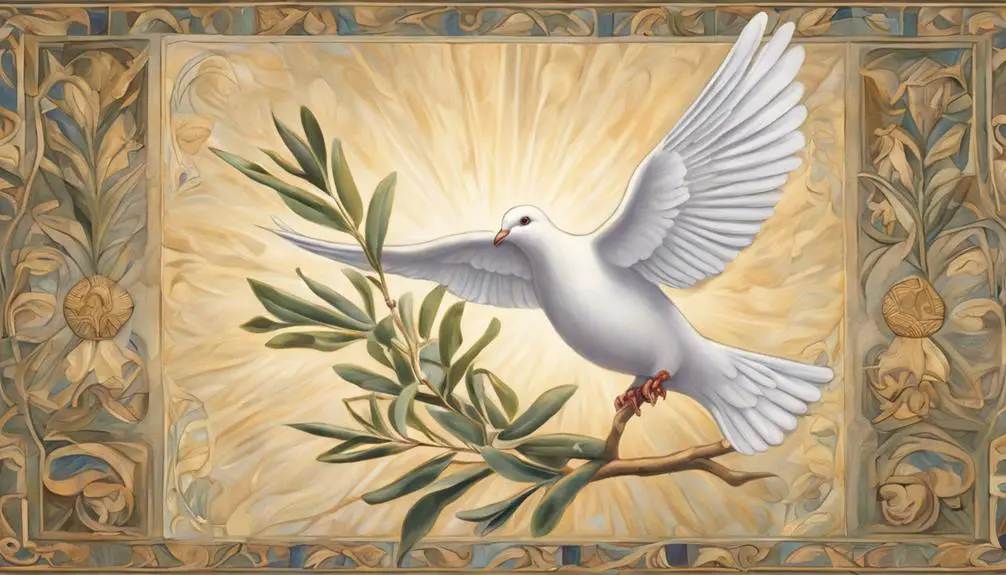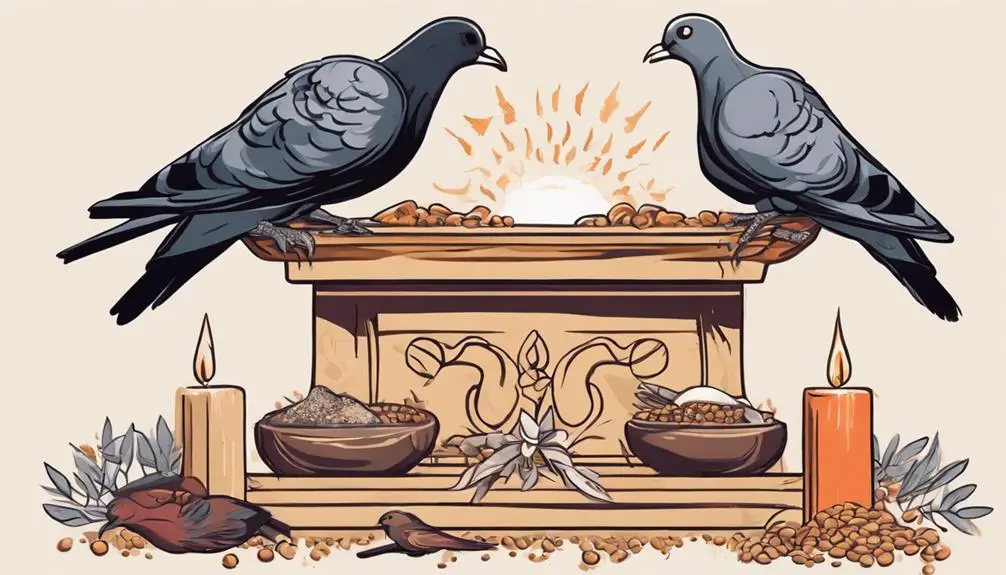Discover the unexpected significance of pigeons in the Bible, from symbols of peace to sacrificial offerings, and uncover deeper theological insights.

Pigeons in the Bible
You might think pigeons are just city dwellers with a knack for finding your freshly washed car, but in the Bible, they're nothing short of extraordinary. From their symbolic representation of peace and the Holy Spirit to their role in Old Testament rituals, these birds carry a weight of significance you may have overlooked.
Consider how pigeons, often seen as offerings of the poor, highlight themes of sacrifice and humility. But there's more to their story, touching on deeper cultural and theological implications that await your exploration.
Why should you care? Because understanding these nuances offers a richer appreciation of a text that has shaped civilizations.
Key Takeaways
- Pigeons symbolize peace, purity, and the Holy Spirit in biblical context.
- They were used in Old Testament rituals for purification and offerings.
- The Holy Spirit is often depicted as a dove, emphasizing purity and peace.
- Pigeons provided a means for the economically disadvantaged to participate in religious practices.
Symbolism of Pigeons

Pigeons, as depicted in biblical texts, often symbolize peace, purity, and the divine spirit, embodying complex theological concepts with their mere presence. This association isn't just a superficial one; it's deeply rooted in the unique characteristics and behaviors of pigeons, notably pigeon navigation and the adaptation of urban pigeons.
You'll find that pigeon navigation, an innate ability to find their way home over long distances, mirrors the spiritual journey of believers towards their divine home. This remarkable skill highlights the pigeons' guidance under a divine hand, a metaphor for spiritual enlightenment and the journey of the soul. Moreover, the adaptability of urban pigeons, thriving in cities just as in their natural habitats, speaks to the omnipresence of the divine spirit in all environments, whether sacred or secular.
Analyzing these traits in the context of biblical symbolism, you discern a deeper message: just as pigeons navigate vast distances and adapt to various surroundings, so too are you called to find your way through the spiritual wilderness of life, guided by divine light, and to remain pure and steadfast in faith, regardless of your environment.
Pigeons in Old Testament Rituals

In the Old Testament, pigeons served as integral components of various rituals, symbolizing purity and acting as offerings to bridge the human-divine connection. These birds, in their diverse varieties, played crucial roles, particularly in rites of ritual purification. You'll find that the Law prescribed these birds for individuals who couldn't afford larger sacrifices, demonstrating a profound understanding of economic inclusivity within religious practices.
The use of pigeon varieties in these rituals wasn't arbitrary. Each type had its significance, meticulously chosen for specific ceremonies. For instance, the selection between a turtledove and a young pigeon often depended on the availability and the economic status of the person offering the sacrifice. This choice underscores the flexibility and accessibility of the sacrificial system, ensuring that all had the means to seek purification and reconciliation with God.
Ritual purification, especially after childbirth or in the cleansing of leprosy, mandated the offering of pigeons. This practice highlights the birds' symbolic association with new beginnings and cleanliness, essential themes in these rituals. Their blood, considered pure and cleansing, served as a powerful symbol of renewal and forgiveness, further cementing pigeons' role in bridging the sacred and the mundane.
The Holy Spirit and Pigeons

While exploring the symbolic roles pigeons played in Old Testament rituals, it's also crucial to examine their representation of the Holy Spirit in biblical narratives. The connection between pigeons and the Holy Spirit is most vividly illustrated through dove comparisons. These comparisons aren't merely coincidental but carry deep theological significance.
Here are three key points to understand this connection:
- Purity and Peace: Doves are universally recognized symbols of purity and peace. This mirrors the Holy Spirit's role in bringing peace to the believer's heart and purifying them from sin.
- Heavenly Descent: The New Testament describes the Holy Spirit descending like a dove during Jesus' baptism. This moment highlights the gentleness and grace of the Holy Spirit's entrance into the believer's life, akin to a dove's serene descent.
- Artistic Representations: Throughout Christian history, artists have depicted the Holy Spirit as a dove, drawing on biblical imagery. These artistic representations serve as a visual reminder of the Spirit's transcendent peace and purity.
Pigeons as Offerings of the Poor

Amidst the various offerings prescribed in the Old Testament, pigeons stood out as the preferred sacrifice for those of limited means, highlighting their economic and spiritual significance within ancient Israelite society. This distinctive choice wasn't arbitrary but deeply rooted in the dietary laws and economic realities of the time. According to Levitical codes, pigeons, along with doves, were acceptable offerings for those who couldn't afford more costly sacrifices, such as lambs or goats. This provision ensured that the economically disadvantaged could still participate in religious rituals, maintaining spiritual purity and community cohesion.
The economic implications of this practice were profound. Pigeons were widely available and could be raised by individuals who lacked the land for larger livestock. Thus, they served as a democratizing element in religious observance, reinforcing the principle that access to the divine wasn't reserved for the wealthy or powerful. Furthermore, by integrating pigeons into the sacrificial system, the biblical dietary laws facilitated a means of inclusion, allowing the poor to fulfill their religious obligations without exacerbating their financial hardship. This aspect of ancient Israelite worship underscores the intricate relationship between religious practices, social equity, and economic sustainability.
Cultural Impact of Biblical Pigeons

The cultural impact of pigeons, as depicted in biblical texts, extends far beyond their role in ancient sacrifices, shaping societal norms and religious symbolism throughout history. This influence can be dissected into several key areas, each highlighting the profound bond between humans and these birds.
- Symbolism in Religious Texts: Pigeons have been emblematic of peace, purity, and the Holy Spirit within Christian theology. This portrayal influences religious practices and art, embedding the bird as a symbol of divine presence and human aspiration towards holiness.
- Pigeon Folklore: Across cultures, biblical narratives have intertwined with local traditions to create rich pigeon folklore. These stories often emphasize themes of hope, guidance, and divine intervention, reinforcing the bird's sacred status and its role as a bridge between the mundane and the heavenly.
- Urban Pigeons and Social Perception: The presence of pigeons in urban settings, often seen as descendants of their wild, biblical counterparts, continues to affect how societies view these birds. While sometimes considered pests, they also serve as living reminders of our historical and spiritual connections to the natural world, echoing biblical notions of coexistence and care for all creatures.
Analyzing these aspects reveals the multifaceted cultural significance of biblical pigeons, underscoring their enduring legacy in shaping human perspectives on nature, divinity, and community.
Frequently Asked Questions
How Do Modern Scholars Interpret the Absence of Pigeons in Certain Biblical Narratives Where Birds Are Symbolically Significant?
Modern scholars analyze the absence of pigeons in key biblical narratives with significant bird symbolism. They consider cultural and historical contexts to understand these omissions, interpreting pigeon symbolism.
Their insights often suggest that pigeons, symbolizing peace or sacrifice, might not align with the narrative purpose or theological message intended. This detailed, scholarly approach reveals the complexities behind the scenes, offering insight into the nuanced decisions of biblical authors.
Are There Any Notable Differences in the Depiction of Pigeons Across Various Translations and Editions of the Bible?
You'll find that pigeon symbolism varies across different translations and editions of the Bible, highlighting translation discrepancies. Scholars analyze these variations to understand the nuanced meanings pigeons might carry in biblical contexts.
Whether a translation emphasizes purity, sacrifice, or messengership can significantly alter your interpretation of the text. These differences underscore the importance of comparing translations for a fuller understanding of pigeon symbolism in biblical narratives.
How Have Interpretations of Pigeons' Roles in the Bible Evolved With Modern Christianity, Especially in Non-Western Contexts?
You've likely noticed that modern interpretations of pigeon symbolism in Christianity have evolved, especially in non-Western contexts. Scholars delve into how these birds, once seen as mere sacrificial animals, are now often interpreted as symbols of peace and the Holy Spirit.
This shift reflects broader changes in theological approaches, emphasizing a more universal, inclusive understanding of biblical symbols that resonate across diverse cultures, enriching the global Christian narrative.
Was There Any Specific Breed or Color of Pigeon That Was Preferred for Rituals and Offerings in Biblical Times, According to Historical Records or Archaeological Findings?
You're diving into whether a specific pigeon breed or color was favored for ancient rituals and offerings. Historical records and archaeological findings don't pinpoint a particular breed due to the complexity of pigeon genetics and the absence of modern breeding techniques.
However, the preference likely leaned towards readily available and symbolic colors or types, aligning with the cultural and religious significance of the time, rather than a strict breed specificity.
How Have Pigeons Mentioned in the Bible Influenced the Perception and Treatment of These Birds in Contemporary Religious Practices Outside of Christianity?
Imagine the humble pigeon, often dismissed as merely an urban dweller, yet rich in folklore across cultures.
The Bible's portrayal of pigeons has subtly influenced their perception in contemporary religious practices outside Christianity. This ancient text's reference casts them in a sacred light, elevating their status.
Their remarkable urban adaptation further intertwines with their symbolic significance, suggesting resilience and purity, shaping how various beliefs outside Christianity now view and treat these adaptable birds.
Conclusion
In conclusion, pigeons in the Bible aren't just background characters; they're emblematic of humility, purity, and the divine. From their role in Old Testament rituals to symbolizing the Holy Spirit, they offer a unique lens into biblical symbolism.
Their status as offerings for the impoverished underscores a profound message of inclusivity and grace. The cultural reverberations of these biblical pigeons are timeless, echoing virtues that transcend eras—serving as the ancient world's tweets heralding messages of hope and renewal.



Sign up